| Srl | Item |
| 1 |
ID:
119320
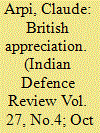

|
|
|
| 2 |
ID:
128666
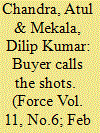

|
|
|
| 3 |
ID:
096018
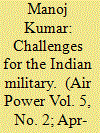

|
|
|
| 4 |
ID:
116300
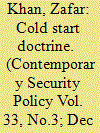

|
|
|
|
|
| Publication |
2012.
|
| Summary/Abstract |
A reaction by the Indian military to a series of violent crises with Pakistan, beginning with the Kargil conflict of 1999, Cold Start Doctrine (CSD) envisions limited attacks on Pakistan territory as non-nuclear retaliation against asymmetric and proxy attacks. Cold Start Doctrine and Pakistani responses show that the South Asian region is still adjusting to the consequences of overt nuclearization in 1998. India and Pakistan remain prone to arms racing and vulnerable to destablization. CSD is part of an action-reaction process, increasing risks of war and the risk that nuclear weapons would be used should war occur. It worsens the natural tension between India's desire for resolution through conventional conflict and Pakistan's declared willingness to escalate to nuclear first use. For India, CSD increases incentives to abandon its previous commitment to nuclear No First Use. Probable Pakistani responses include development of tactical nuclear weapons, forward deployment of nuclear forces, and pre-delegation of launch authority, increasing its problems of force protection, command and control, and escalation control. This article concludes, based on reliable sources, that neither of these war-like strategies benefits the two nuclear rivals as each state's policy options confront certain issues that invite strategic instability in South Asian region and should be reconsidered.
|
|
|
|
|
|
|
|
|
|
|
|
|
|
|
|
| 5 |
ID:
130089
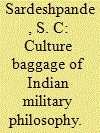

|
|
|
|
|
| Publication |
2014.
|
| Summary/Abstract |
The Gandhi an philosophy at ahimsa has attested the Indian attitude towards war and use of force. Nehruvian distrust ot India's armed forces and military leadership has coloured the dispensation national defence and the armed forces get. Historical, intellectual, cultural and administrative neglect oi the need for national defence cause deep concern. The people and their elected representatives have indifference to and inadequate knowledge of defence matters, their imperatives, demands and consequences. Bhutto said, "We will eat grass, but produce an atomic weapon". This awareness and determination does not sink in our Indian thought. Indian attitude resonates to its cultural ethos - waiting tor something to happen, somewhere, somehow, some time and somebody to take care, without designing things.
|
|
|
|
|
|
|
|
|
|
|
|
|
|
|
|
| 6 |
ID:
160626
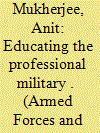

|
|
|
|
|
| Summary/Abstract |
This article analyzes the ways in which civil–military relations shape professional military education (PME). Its main argument is that military education benefits from a civil–military partnership. In doing so, the article examines the role of civil–military relations in shaping PME in India. While describing the evolution of military education in India, it analyzes its weaknesses and argues that this is primarily due to its model of civil–military relations, with a limited role for civilians. Theoretically, this argument challenges Samuel Huntington’s notion of “objective control”—which envisaged a strict separation between the civil and military domains. Conceptually, this article argues for a greater dialogue on military education among civilians, both policy makers and academics, and military officers and not to leave it to the military’s domain—as is currently the practice in most countries.
|
|
|
|
|
|
|
|
|
|
|
|
|
|
|
|
| 7 |
ID:
131670
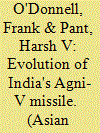

|
|
|
|
|
| Publication |
2014.
|
| Summary/Abstract |
India's Agni-V missile test of April 2012 opens new questions as to India's intentions. This article investigates three principal bureaucratic determinants of Indian military nuclear policy. Greater control over policymaking is required from the Prime Minister's Office to resolve governance questions surrounding India's nuclear policy.
|
|
|
|
|
|
|
|
|
|
|
|
|
|
|
|
| 8 |
ID:
109826
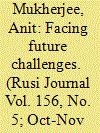

|
|
|
| 9 |
ID:
151423
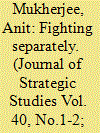

|
|
|
|
|
| Summary/Abstract |
How do countries transition from single service to joint operations? This article engages with the discussion on military innovation to argue that civil–military relations are the most important driver for jointness. In doing so it examines jointness in the Indian military. Relying on archival research and primary interviews this article sheds new light on the operations of the Indian Peacekeeping Forces (IPKF) in Sri Lanka from 1987–1990, the 1999 Kargil War and the Post-Kargil defence reforms. The main argument is that the Indian military’s transition to jointness has been ‘incomplete’ primarily because of its prevailing model of civil-military relations. This model prevents civilians from interfering in the operational issues of the military, including on matters pertaining to jointness. It therefore recommends more forceful civilian intervention to overcome the prevailing single service approach.
|
|
|
|
|
|
|
|
|
|
|
|
|
|
|
|
| 10 |
ID:
130014
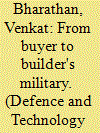

|
|
|
| 11 |
ID:
121138
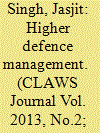

|
|
|
| 12 |
ID:
121139
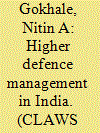

|
|
|
| 13 |
ID:
131297
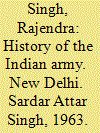

|
|
|
|
|
| Publication |
New Delhi, Sardar Attar Singh, 1963.
|
| Description |
xv, 283p.Hbk
|
| Contents |
B
|
|
|
|
|
|
|
|
|
|
|
|
Copies: C:1/I:0,R:0,Q:0
Circulation
| Accession# | Call# | Current Location | Status | Policy | Location |
| 057778 | 355.00954/SIN 057778 | Main | On Shelf | General | |
|
|
|
|
| 14 |
ID:
093330


|
|
|
|
|
| Publication |
2009.
|
| Summary/Abstract |
India has come a long way from the days when it used to be the world's largest recipient of foreign aid. Today India's foreign aid constitutes only less then 0.3 percent of the country's national GDP.
|
|
|
|
|
|
|
|
|
|
|
|
|
|
|
|
| 15 |
ID:
176575
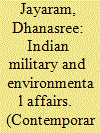

|
|
|
|
|
| Summary/Abstract |
In India, issues related to environmental governance have not been aligned to the military’s objectives except in a few cases. Since environmental change has not been recognised as a critical 'security' issue yet in India, there is a reluctance on the part of the security establishment, including the military, to deal with it on an urgent basis. The question of why the armed forces should be trained to undertake environmental activities when their primary duty is to defend the country against external aggression assumes significance as it is largely believed that if they are trained for the former, their primary functions could suffer and territorial integrity of the nation could be threatened. Other impediments to institutionalisation include the complex relations between the civil and military establishments; constitutional and legal status of the Indian armed forces that is not uniformly enshrined or recognised; and their societal status that still comes under constant scrutiny, leading to a wedge between the military and civilian domains. In this context, the article attempts to identify the doctrinal and policy dimensions of the Indian military’s role in environmental affairs as well as the factors that influence formal institutionalisation.
|
|
|
|
|
|
|
|
|
|
|
|
|
|
|
|
| 16 |
ID:
143829
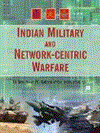

|
|
|
|
|
| Publication |
New Delhi, Wisdom Tree, 2014.
|
| Description |
xxiii, 271p.hbk
|
| Standard Number |
9788183283625
|
|
|
|
|
|
|
|
|
|
|
|
Copies: C:1/I:0,R:0,Q:0
Circulation
| Accession# | Call# | Current Location | Status | Policy | Location |
| 058474 | 355.020954/KAT 058474 | Main | On Shelf | General | |
|
|
|
|
| 17 |
ID:
176948
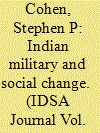

|
|
|
| 18 |
ID:
187205
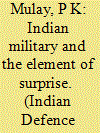

|
|
|
| 19 |
ID:
102239
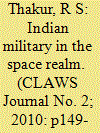

|
|
|
| 20 |
ID:
129367
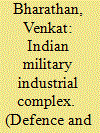

|
|
|
|
|
| Publication |
2012.
|
| Summary/Abstract |
In earlier columns I had written about defence expositions and the many of defence technology: Innovation, Invention, Induction, Integration, Industrialization. The obvious reality that India needs a military industrial complex needs to be addressed.
|
|
|
|
|
|
|
|
|
|
|
|
|
|
|
|